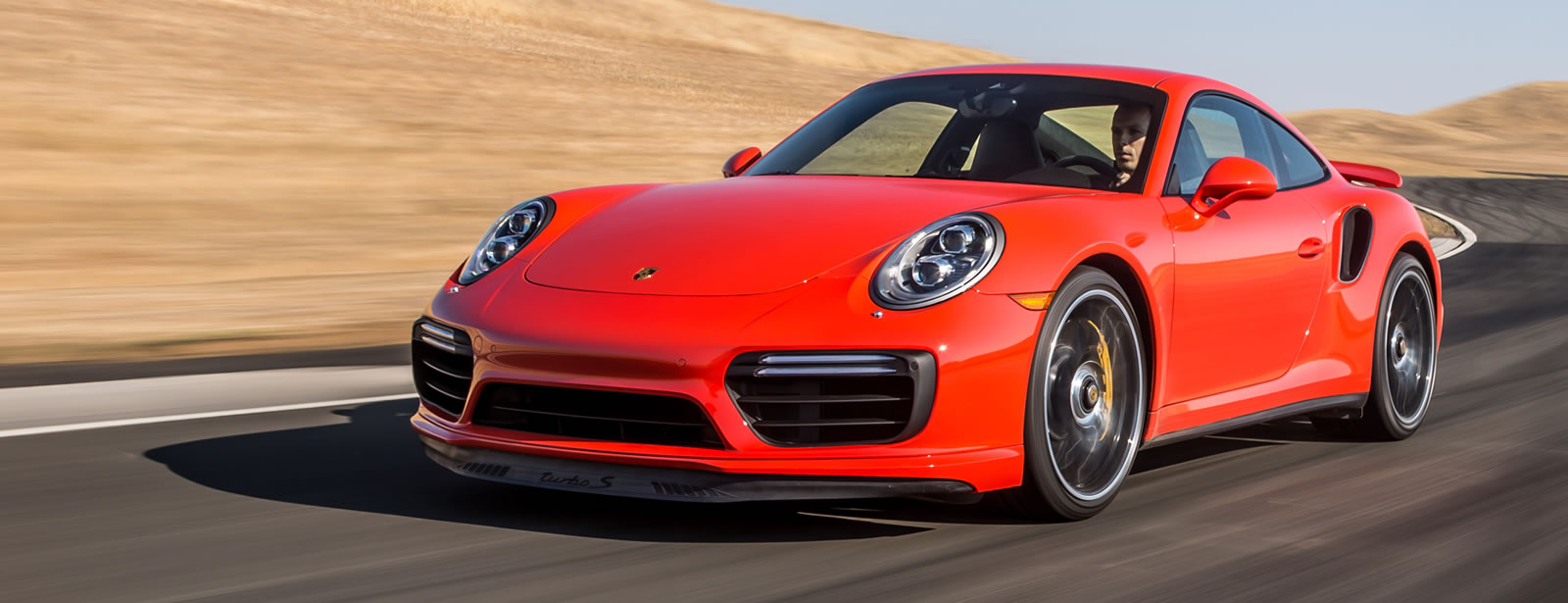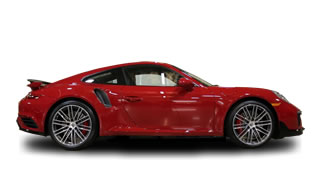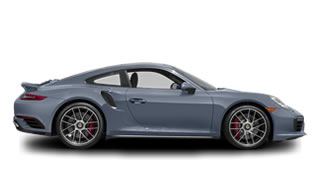2017 Porsche 911 Turbo
2017 Porsche 911 Turbo Overview 
2017 Porsche 911 Turbo For Sale
Porsche 911 Turbo For Sale
2017 Porsche 911 Turbo Performance 
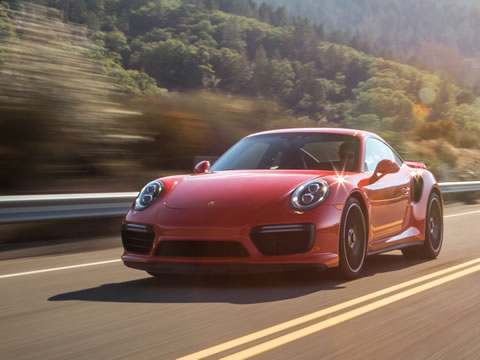
Performance
For the best possible intermediate acceleration, the Sport Chrono Package comes with four programs and the Sport Response button as a standard option. Acceleration is stronger than ever before: the 911 Turbo Coupe sprints from zero to 60 miles per hour in 2.9 seconds, and the 911 Turbo S in 2.8 seconds — each is 0.1 seconds faster than the previous model. The Cabriolet variants need just 0.1 second more than the coupes to reach 60 mph. Top track speeds are higher as well reaching speeds of 205 miles per hour for the 911 Turbo S (7 mph faster than before) and 198 miles per hour for the 911 Turbo (3 mph faster).

Revised Gear Selector Strategy and Transmission Programming
The operation and programming of the Porsche Doppelkupplung transmission (PDK) in the new generation of 911 Turbo shows even closer ties to motorsport. When the gear selector is in manual mode, the shifting direction to select a higher or lower gear has been reversed compared to the previous model. It is now essentially identical to that used in the 911 GT3, the 911 GT3 RS and in race cars. Pushing the gear selector forward initiates a downshift, and pulling the lever back an upshift. The system also prevents automatic upshifting in manual mode, giving the driver full control over the shifting process. The engine now bounces off the rev limiter, clearly audibly indicating the necessity to upshift.

Redefining Fast
Higher boost pressure increases the output of the twin-turbo six-cylinder engine in the 911 Turbo to 540 hp. Thanks to its turbochargers with larger impellers and other enhancements, the 911 Turbo S now develops 580 hp. In addition to a higher maximum torque (553 lb.-ft. in overboost compared to 523 lb.-ft. on the Turbo), the Turbo S also has a higher redline with 7200 rpm instead of 7000. Porsche is still the only manufacturer to use two turbochargers with variable turbine geometry in a gasoline engine.This enables breathtaking acceleration figures for the new high-performance sports cars. The 911 Turbo S Coupe sprints from zero to 60 miles per hour in 2.8 seconds (0.1 seconds faster than the 560 hp predecessor). Its top track speed of 205 miles per hour is 7 miles per hour faster than the previous 911 Turbo S model. The 911 Turbo Coupe reaches 60 miles per hour in 2.9 seconds. Its top speed is 198 miles per hour – 3 miles per hour faster than before.
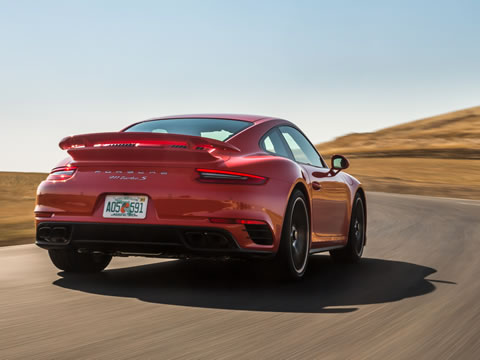
Dynamic Boost: Throttle Response with Practically No Delay
Dynamic Boost reduces the response time of turbocharged engines to load changes to a barely perceptible minimum. This is particularly noticeable when reapplying the throttle after braking for a turn. When the accelerator pedal is pressed, the engine responds with practically no delay. To do this, Dynamic Boost maintains boost pressure. Normally, the engine control unit closes the throttle valve when the driver releases the accelerator pedal, which results in a drop in boost pressure. Dynamic Boost keeps the throttle valve open, and it only interrupts the fuel supply. As a result, the turbocharger continues to generate boost pressure, which improves throttle response and acceleration when the accelerator pedal is pressed again. Dynamic Boost is always active, but it has more pronounced effects in the Sport modes. The boost pressure gauge on the instrument cluster informs the driver of how the system is being used.
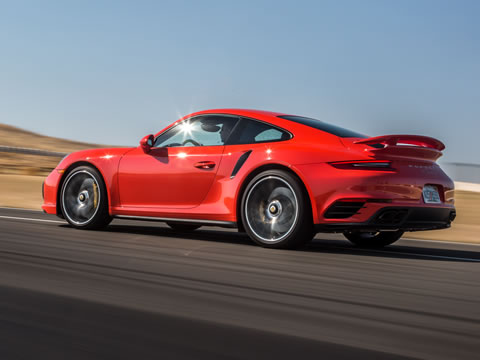
Sport Response Button
A new feature is the Sport Response Button located at the center of the mode switch. Inspired by racing, it sharpens the vehicle's responsiveness at the push of a button. When the Sport Response Button is pressed, the engine and transmission are calibrated for maximum responsiveness. In the part-load range, Porsche Dopplekuplung (PDK) immediately downshifts one gear so that engine speed is in an optimal range: between 3,000 rpm and 6,000 rpm. At the same time, PDK uses a special gear shift mapping compared to the Sport Plus mode, delaying upshifts to a higher gear. In addition, the ignition timing is retarded, and the turbocharger blades close using variable turbine geometry. At the same time, the throttle valve is slightly opened, which increases mass flow, and the speed of the turbocharger's turbine wheel rises. The next time the accelerator pedal is pressed, the engine reacts much more directly and develops its maximum power faster. The Dynamic Boost function also switches to Performance mode. After 20 seconds, the vehicle automatically returns to the previously selected mode. A timer that counts down in the instrument cluster informs the driver how much longer the Sport Response function will still be active. The function can be deactivated by pressing the Sport Response button again and can be used as often as desired.
2017 Porsche 911 Turbo Appearance 
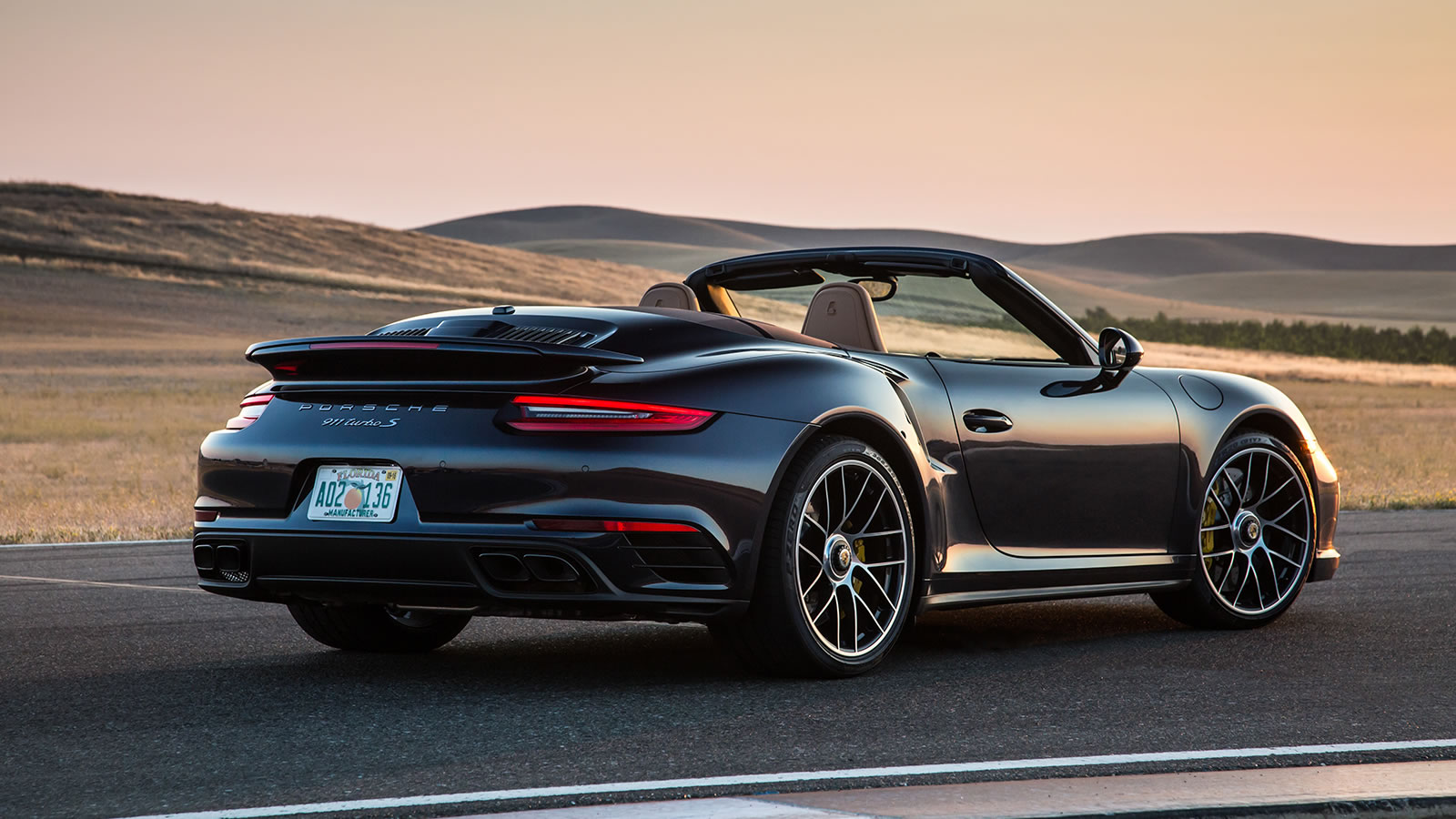
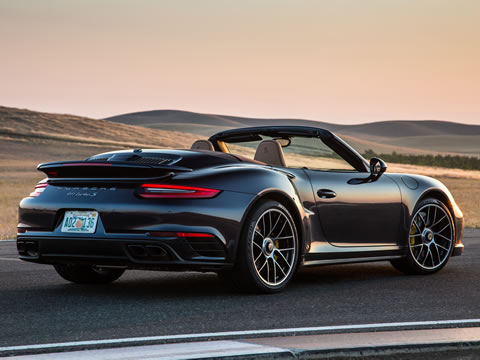
Sharper Design with New Traits
Visually, the new 911 Turbo generation incorporates the distinctive design features of the new 2017 911 Carrera models, accompanied by the typical styling cues of the 911 Turbo. The new front fascia with side airblades and LED front lights with position lights and direction indicators give the front end a wider look along with the additional louver in the middle air intake. The LED headlights — now standard in the 911 Turbo models coupled with the Porsche Dynamic Light System (PDLS) — include four-point daytime running lights, dynamic leveling control, speed-dependent headlight range control, dynamic cornering lights and a headlight cleaning system. The 911 Turbo S models also offer the dynamic, camera-based PDLS Plus headlights with high beam assistant.
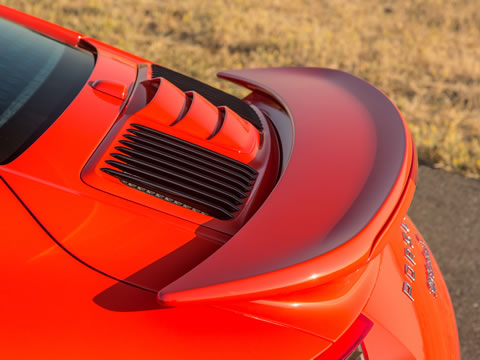
Porsche Active Aerodynamics Combine Downforce with Efficiency
An Aerokit is optionally available for the 911 Turbo models, providing up to 40 pounds of additional downforce at 186 mph. It encompasses a new front spoiler with side fins and a completely redesigned rear deck lid that has a fixed rear spoiler with side winglets while maintaining the automatically adjusting rear wing.
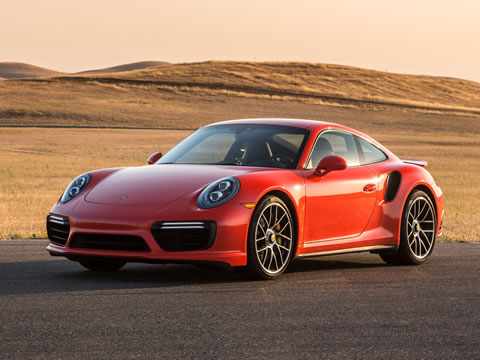
New Exterior and Interior Colors
Carmine Red and Miami Blue are new available special colors for the 911 Turbo models. Inside, Saddle Brown is available as a new leather color; also new is the special color Bordeaux Red. The two-tone Black/Bordeaux red interior is being offered as the standard color scheme for the 911 Turbo S models for the first time.
2017 Porsche 911 Turbo Comfort 

Infotainment
The new Porsche Communication Management system with online navigation and a state-of-the-art touchscreen is as easy to operate as a smartphone. Online capability has been improved to include real-time traffic information, Google Earth and Google Street View. The system can be readily paired with a smartphone, providing access to many more apps.

Sport Steering Wheel
The new GT sports steering wheel features electric height and reach adjustment, a MODE switch with SPORT Response button and two gearshift paddles made from an alloy. They are ergonomically located behind the left- and right-hand steering wheel spokes. As an option, the steering wheel is available with multifunction controls for operating audio and communications functions, as well as the on-board computer. The steering wheel rim can then also be heated by pressing a button on the steering wheel.
2017 Porsche 911 Turbo Safety 
New Car Limited Warranty & Porsche 24-Hour Roadside Assistance Program for 4-Years / 50,000 Miles (whichever occurs first)

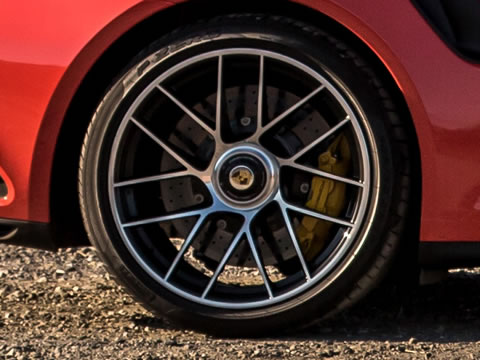
Automatic Post-Collision Braking System Reduces Severity of Collisions
To reduce the severity of collisions, Porsche is now also implementing the automatic post-collision braking system in the 911 Turbo. After an initial collision, it automatically brakes the vehicle to slow it. This is done even if the driver is no longer pressing the brake pedal. This can prevent secondary collisions or reduce their severity. The driver can override the system at any time by pressing harder on the brake pedal or accelerating.

Lane Changes Assist Monitors Blind Spots
Like the 2017 911 Carrera and Targa models, the new 911 Turbo is available with Lane Change Assist. This system monitors the drivers blind spots and areas to the rear of the vehicle on both sides behind using a radar sensor. If the system detects another vehicle in the blind spot, it informs the driver using a visual signal in the corresponding door mirror panel. The system is active over a speed range from 20 to 155 miles per hour, and it can be activated or deactivated in the instrument cluster.
2017 Porsche 911 Turbo Specification 
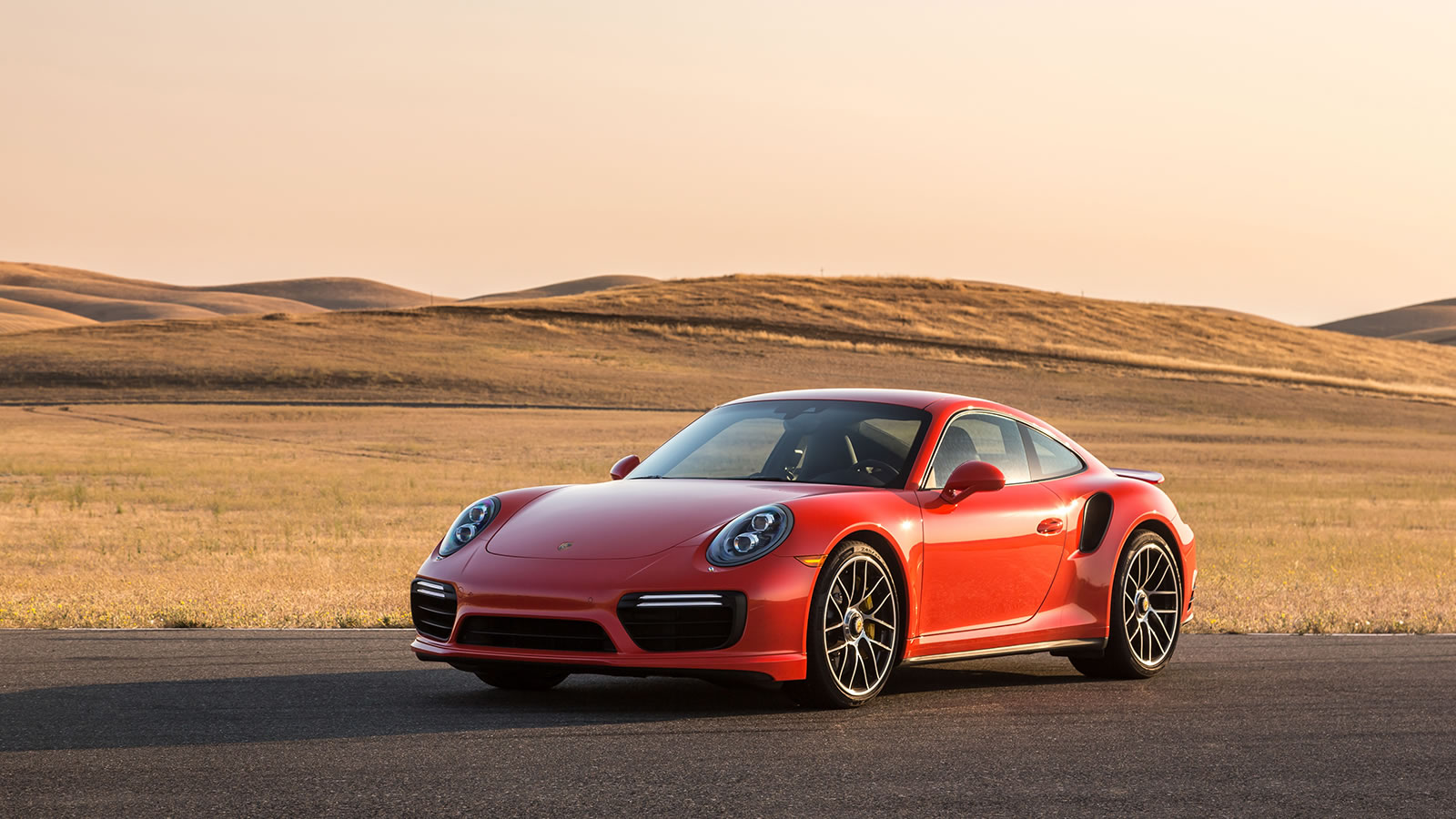
| 911 Turbo | 911 Turbo Cabriolet | 911 Turbo S | 911 Turbo S Cabriolet | |
|---|---|---|---|---|
| Engine | ||||
| Engine layout | Rear Engine | Rear Engine | Rear Engine | Rear Engine |
| Engine type | Boxer, twin-turbo | Boxer, twin-turbo | Boxer, twin-turbo | Boxer, twin-turbo |
| Cylinders | 6 | 6 | 6 | 6 |
| Valves per cylinder | 4 | 4 | 4 | 4 |
| Construction | Aluminum crankcase and heads | Aluminum crankcase and heads | Aluminum crankcase and heads | Aluminum crankcase and heads |
| Fuel injection | Direct Fuel Injection (DFI) | Direct Fuel Injection (DFI) | Direct Fuel Injection (DFI) | Direct Fuel Injection (DFI) |
| Fuel | Premium | Premium | Premium | Premium |
| Displacement (Liters) | 3.8 l | 3.8 l | 3.8 l | 3.8 l |
| Bore/Stroke (mm/mm) | 102 mm / 77.5 mm | 102 mm / 77.5 mm | 102 mm / 77.5 mm | 102 mm / 77.5 mm |
| Maximum power output @ engine speed | 540 hp @ 6400 | 540 hp @ 6400 | 580 hp @ 6750 | 580 hp @ 6750 |
| Maximum torque with Overboost @ engine speed | 523 lb.-ft. @ 2250-4000 | 523 lb.-ft. @ 2250-4000 | 553 lb.-ft. @ 2250-4000 | 553 lb.-ft. @ 2250-4000 |
| Maximum torque @ engine speed | 486 lb.-ft. @ 1950-5000 | 486 lb.-ft. @ 1950-5000 | 516 lb.-ft. @ 2100-4250 | 516 lb.-ft. @ 2100-4250 |
| Maximum engine speed | 7000 | 7000 | 7200.0 | 7200.0 |
| Compression ratio | 9.8 : 1 | 9.8 : 1 | 9.8 : 1 | 9.8 : 1 |
| Output per liter | 142.1 hp | 142.1 hp | 152.6 hp | 152.6 hp |
| Lubrication | Integrated dry-sump | Integrated dry-sump | Integrated dry-sump | Integrated dry-sump |
| Electrical System | 12 V, 2100 W alternator; battery capacity 95 Ah | 12 V, 2100 W alternator; battery capacity 95 Ah | 12 V, 2100 W alternator; battery capacity 95 Ah | 12 V, 2100 W alternator; battery capacity 95 Ah |
| Power to weight ratio (lb/hp) | 6.5 | 6.8 | 6.1 | 6.3 |
| Drivetrain | Active all wheel drive | Active all wheel drive | Active all wheel drive | Active all wheel drive |
| Chassis & Suspension | ||||
| Body | Monocoque lightweight body in a combination of steel, aluminum and magnesium | Monocoque lightweight body in a combination of steel, aluminum and magnesium | Monocoque lightweight body in a combination of steel, aluminum and magnesium | Monocoque lightweight body in a combination of steel, aluminum and magnesium |
| Front Axle | MacPherson strut with anti-roll bar | MacPherson strut with anti-roll bar | MacPherson strut with anti-roll bar | MacPherson strut with anti-roll bar |
| Rear Axle | Aluminum multi-link with anti-roll bar | Aluminum multi-link with anti-roll bar | Aluminum multi-link with anti-roll bar | Aluminum multi-link with anti-roll bar |
| Steering System | Variable ratio electromec. power steering | Variable ratio electromec. power steering | Variable ratio electromec. power steering | Variable ratio electromec. power steering |
| Steering Ratio | 15.0 : 1 (on-center) to 12.5 : 1 | 15.0 : 1 (on-center) to 12.5 : 1 | 15:0 : 1 (on-center) to 12.5 : 1 | 15.0 : 1 (on-center) to 12.5 : 1 |
| Turning Circle | 34.8 ft | 34.8 ft | 34.8 ft | 34.8 ft |
| Brakes & Wheels | ||||
| Caliper type | Aluminum monobloc fixed-caliper brake | Aluminum monobloc fixed-caliper brake | Aluminum monobloc fixed-caliper brake | Aluminum monobloc fixed-caliper brake |
| Rotor material | Steel | Steel | Ceramic Composite | Ceramic Composite |
| Caliper color | Red | Red | Yellow | Yellow |
| Number of pistons (front/rear) | 6 / 4 | 6 / 4 | 6 / 4 | 6 / 4 |
| Rotor diameter (front/rear) mm | 380 mm / 380 mm | 380 mm / 380 mm | 410 mm / 390 mm | 410 mm / 390 mm |
| Rotor thickness (front/rear) mm | 34 mm / 30 mm | 34 mm / 30 mm | 36 mm / 32 mm | 36 mm / 32 mm |
| Name and option # | 20" Turbo | 20" Turbo | 20" Turbo S | 20" Turbo S |
| Standard wheels (front/rear) | 9J x 20" ET51 / 11,5J x 20" ET56 | 9J x 20" ET51 / 11,5J x 20" ET56 | 9J x 20" ET51 / 11,5J x 20" ET56 | 9J x 20" ET51 / 11,5J x 20" ET52 |
| Tires (front/rear) | 245/35 ZR 20 / 305/30 ZR 20 | 245/35 ZR 20 / 305/30 ZR 20 | 245/35 ZR 20 / 305/30 ZR 20 | 245/35 ZR 20 / 305/30 ZR 20 |
| Transmission | ||||
| Number of gears | 7 | 7 | 7 | 7 |
| Transmission type | 7-speed PDK | 7-speed PDK | 7-speed PDK | 7-speed PDK |
| Ratios | ||||
| 1st | 3.91 | 3.91 | 3.91 | 3.91 |
| 2nd | 2.29 | 2.29 | 2.29 | 2.29 |
| 3rd | 1.58 | 1.58 | 1.58 | 1.58 |
| 4th | 1.18 | 1.18 | 1.18 | 1.18 |
| 5th | 0.94 | 0.94 | 0.94 | 0.94 |
| 6th | 0.79 | 0.79 | 0.79 | 0.79 |
| 7th | 0.62 | 0.62 | 0.62 | 0.62 |
| Reverse | 3.55 | 3.55 | 3.55 | 3.55 |
| Front Axle Ratio | 3.4 | 3.4 | 3.4 | 3.44 |
| Rear Axle Ratio | 3.3 | 3.3 | 3.3 | 3.33 |
| Final Drive Ratio | TBD | TBD | TBD | TBD |
| Clutch/Converter diameter (inches) | 8.7 / 6.4 inches | 8.7 / 6.4 inches | 8.7 / 6.4 inches | 8.7 / 6.4 inches |
| Dimensions, Aerodynamics, & Weight | ||||
| Length (inches/mm) | 177.4 in. / 4507 mm | 177.4 in. / 4507 mm | 177.4 in. / 4507 mm | 177.4 in. / 4507 mm |
| Wheelbase (inches/mm) | 96.5 in. / 2450 mm | 96.5 in. / 2450 mm | 96.5 in. / 2450 mm | 96.5 in. / 2450 mm |
| Width w/ mirrors (inches/mm) | 77.9 in. / 1978 mm | 77.9 in. / 1978 mm | 77.9 in. / 1978 mm | 77.9 in. / 1978 mm |
| Width w/o mirrors (inches/mm) | 74.0 in. / 1880 mm | 74.0 in. / 1880 mm | 74.0 in. / 1880 mm | 74.0 in. / 1880 mm |
| Height | 51.0 in. / 1297 mm | 50.9 in. / 1294 mm | 51.0 in. / 1297 mm | 50.9 in. / 1294 mm |
| Track width front (inches/mm) | 60.7 in. / 1541 mm | 60.7 in. / 1541 mm | 60.7 in. / 1541 mm | 60.7 in. / 1541 mm |
| Track width rear (inches/mm) | 62.6 in. / 1590 mm | 62.6 in. / 1590 mm | 62.6 in. / 1590 mm | 62.6 in. / 1590 mm |
| Drag coefficient (Cd) | 0.31 | 0.32 | 0.31 | 0.32 |
| Legroom (inches) | TBD | TBD | TBD | TBD |
| Headroom (inches) | TBD | TBD | TBD | TBD |
| Cargo area volume (cu.-ft.) front trunk | 115 l / 4.06 cu.-ft. | 115 l / 4.06 cu.-ft. | 115 l / 4.06 cu.-ft. | 115 l / 4.06 cu.-ft. |
| Cargo area volume (cu.-ft.) rear seats | 260 l / 9.18 cu.-ft. | 160 l / 5.65 cu.-ft. | 260 l / 9.18 cu.-ft. | 160 l / 5.65 cu.-ft. |
| Fuel tank capacity - refill volume (gal) | 17.9 gal. | 17.9 gal. | 17.9 gal. | 17.9 gal. |
| Curb weight (lbs) | 3516 lbs. | 3671 lbs. | 3527 lbs. | 3682 lbs. |
| Gross Vehicle Weight (lbs) | 4431 lbs. | 4553 lbs. | 4387 lbs. | 4509 lbs. |
| Payload range (lbs) - depend on options | 915 lbs. | 882 lbs. | 860 lbs. | 827 lbs. |
| Performance | ||||
| Top track speed (mph) | 198 mph | 198 mph | 205 mph | 205 mph |
| Top track speed- electric only (mph) | ||||
| Acceleration 0-60 (sec) | 2.9 sec. | 3.0 sec. | 2.8 sec. | 2.9 sec. |
| Quarter mile time | 11.0 sec. | 11.2 sec. | 10.8 sec. | 11.0 sec. |
| Fuel Economy/Rating | ||||
| Rating | - | - | - | - |
| City | 19 mpg | 19 mpg | 19 mpg | 19 mpg |
| Highway | 24 mpg | 24 mpg | 24 mpg | 24 mpg |
| Combined | 21 mpg | 21 mpg | 21 mpg | 21 mpg |
